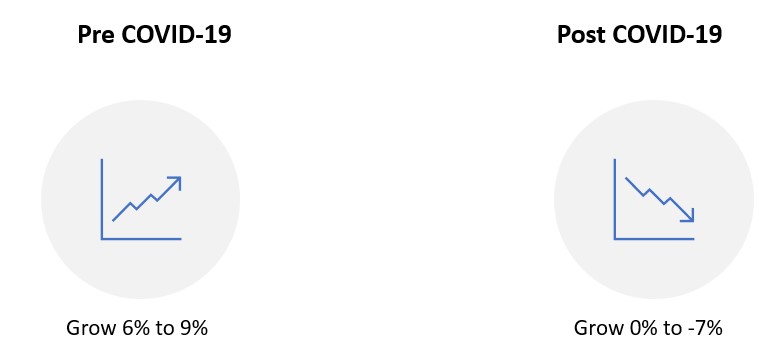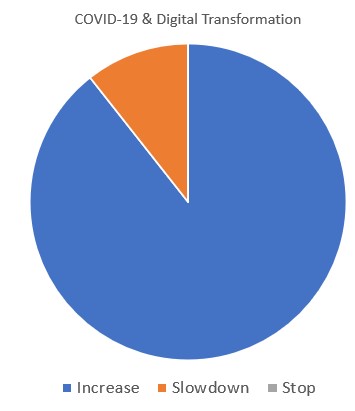COVID-19: Won’t someone think of the vendors?

2020 has been tough globally – on businesses of all types – but won’t someone think of the vendors? When it comes to planning your next 12 – 24 months, it’s important to consider the impact on software vendors and how this might ultimately impact you, their customers.
Won’t someone think of the vendors?
What kind of impact has COVID-19 had on software vendors? Looking at the most recently available results for the four main Tier 1 vendors, we see:

Only Microsoft is doing well during the coronavirus pandemic, with huge upsurges in many of their cloud products including Azure, Office 365, and Teams driving healthy double-digit growth. The other three are reporting figures trending downwards although, even there, their cloud divisions are all growing…just not enough to fully outweigh the drop in on-premises/support spend. The general message of declining revenue and a need to find new revenue quickly applies to many other software vendors too, not just the four above.
Overall market impact
A recent PWC report looked at market growth predictions pre/post COVID-19 and showed:

With the expectation for increased revenue and profit each quarter, many software manufacturers are facing an immediate need to get their numbers back on track. That means they need to get more money out of their customers – many of whom have less money available than at any time in the last decade. How the vendors go about this could have some serious long-term impact on the software industry for the next 5/10 years.
Customer organisations around the world have lost significant portions of their revenue, in some cases permanently, and many are still in crisis mode – keeping the lights on, keeping as many staff employed as possible, ensuing enough cashflow to get them to next month and so on. This is particularly true for certain industries such as retail, hospitality, and travel. Software vendors must be sensible and cautious as they navigate this new landscape and there are two areas where they really must think carefully – contract flexibility and audit activity.
Contract flexibility
If an organisation has been forced to reduce their workforce due to coronavirus – what flexibility is available for them to reduce the numbers on their contracts? Is now the time to rigidly enforce the terms of the contract or is it the time for understanding and compassion?
Take a look at your contracts and identify where there is already flexibility written in. Those that are inflexible – discuss with other stakeholders (procurement, supplier management, CIO for example) how integral they are to your business, and its long-term plans, and then choose an appropriate course of action. It’s always worth going to the vendor and discussing your situation as, ultimately, it’s better for them if their customers stick around for the long haul.
Audit activity
The PWC report mentioned earlier also offered suggestions for things software vendors can do to alleviate the current situation and “license verification” was one of them – as it can “be an effective lever to increase short-term revenue”. There’s plenty of talk about a rise in audits right now and, while there’s no real definitive prove, there is growing anecdotal evidence – so audits should certainly be on your risk register. This is from a range of vendors too – both Tier 1 and Tier 2 appear to be on the prowl.
Opportunity for building or damaging relationships
If vendors work with customers to accommodate their needs during these unique times, they stand to build long-term customer relationships that will benefit them for years to come. If they don’t – and they force organisations to pay for users they no longer have, and/or drop audit bills on them – they stand to do themselves more harm than good in the long term.
Many installations of legacy software remain in use within organisations because to swap to another product would be too much upheaval and may disrupt day-to-day operations. As 2020 is pretty much all upheaval and interrupted operations at the moment, now might be a good time to migrate away from a legacy solution owned by heavy-handed provider to a more modern, probably cheaper, solution from a customer-focused provider who will be easier to deal with in the future.
Backing up the threat
An inflexible contract negotiation or poorly timed, aggressive audit could be the catalyst for a major technology shift. However, empty threats rarely succeed at the negotiation table – the vendor must believe that you dropping their product is a real possibility so work with internal stakeholders to understand the chances of making it a reality:
- How big a saving would be needed to make it worthwhile?
- Have potential alternatives been identified?
- Are resources available to do the work?
Also, as vendors often have lines of communication to various parts of an organisation, ensure everyone internally is on the same page so as not to adversely affect any discussions.
Digital Transformation
I did some research among my awesome LinkedIn network (shout out to all 112 of you!) to get a feel for people’s views on the future of digital transformation and the results are:

Pleasingly, it matched up very well with my own thoughts – that COVID-19 will lead to an increase in digital transformation. Feel free to add your thoughts here – it’s only 1 question 🙂
Digital transformation isn’t the big, costly ERP migrations that some people imagine but rather new ways of doing things like:
-
- Cloud – IaaS & SaaS
- Containers
- Low code/no-code app creation
- Chatbots
- Robotic Process Automation (RPA)
in an effort to enable organisations to work more efficiently, reach new (and existing) customers in new ways, and do more with less.
Satya Nadella said that Microsoft saw “2 years of digital transformation in 2 months” during the Coronavirus outbreak as organisations were forced to adopt new ways of working at a vastly accelerated speed. This will continue too – partly due to the ongoing impact of COVID-19 but also because the past few months have shown not only what is possible but also that things can be done faster than previously thought. If an organisation had a 5-year digital transformation roadmap and now, after 6 months, they’re more than 10% along that path…why would they slow down now?
The next frontier
As these technologies represent a new world for customer organisations, they represent the same for the software vendors. New licensing programs and rules plus new ways of working and purchasing all mean probably new areas for confusion…and revenue. If you work to ensure you’re able to help your organisation understand and manage these new tools, you’ll be able to help ensure the benefits of digital transformation aren’t lost to over licensing and non-compliance bills.
About Rich Gibbons
A Northerner renowned for his shirts, Rich is a big Hip-Hop head, and loves travel, football in general (specifically MUFC), baseball, Marvel, and reading as many books as possible. Finding ways to combine all of these with ITAM & software licensing is always fun!
Connect with Rich on Twitter or LinkedIn.
